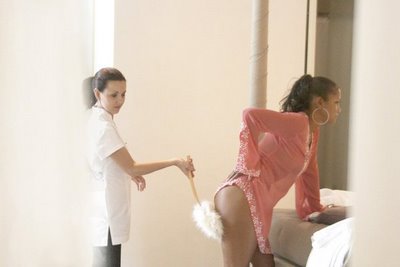Alison Jackson
Sunday, 24 May 2009
Work from Photographs. Here is a little celebrity magic for your Sunday browsing.
“Powerful images dominate the world. Pictures of celebrities who have reached the status of icons or demons. They are news—whether they are the Royal Family, Madonna, Posh and Becks or Britney Spears. This news becomes intrigue; it becomes difficult to differentiate between what is real and what is fantasy, what is important and what is not.
These celebrities are the icons of this contemporary folk religion. The pictures we have of them correspond to the religious pictures of the past. We find ourselves believing that what these pictures portray, really is the whole “truth” about the subject. For example, Marilyn Monroe is just a sex goddess; Britney Spears is white trash; Camilla is usually portrayed with a touch of the wicked old witch and so on.
The question is: How limited a picture do we receive of these icons? We suspect there is much more than we are told or read about. So our imaginations get to work to compensate for our lack of real information. Thus we are continually being seduced away from the “truth” into a world which has no “real” grounds of integrity and authenticity. At best, a photograph of a celebrity reproduces something authentic only at the very moment the shutter clicks. We have been teased and seduced into giving tiny fragments of “reality” an absolute authenticity. Images are by nature titillating and “of fantasy,” aiding this process. The photograph has become more real than the real.
This work is about simulation. Creating a clone or a copy of the “real” on paper. It is not a fake, it takes the place of the “real” for a moment, whilst looking at the image. The aim is to create likenesses of icons, where in the image, the simulations of icons, threatens the difference between “true” and “false,” between “real” and “imaginary”. The “real” subject becomes not necessary. The photographic image or the icon is more important and more seductive. It doesn’t matter to the viewer if the portrayal is not the “real”—as long as it looks like him or her—it creates a temporary confusion. This is the confusion the work searches to create. We think we are looking at something real, but we’re not. They are false images of look-alikes of the real thing.
Nevertheless, the photograph is authentic in one sense, Jane Smith and Jo Bloggs really exist as look-alikes within the image, but they portray a false picture of perception. The photographs reflect what really exists in the public imagination. They highlight the difference between what we see and what we imagine. This is bound up in our inherent greedy voyeurism and our need to believe.” – statement from M+B




